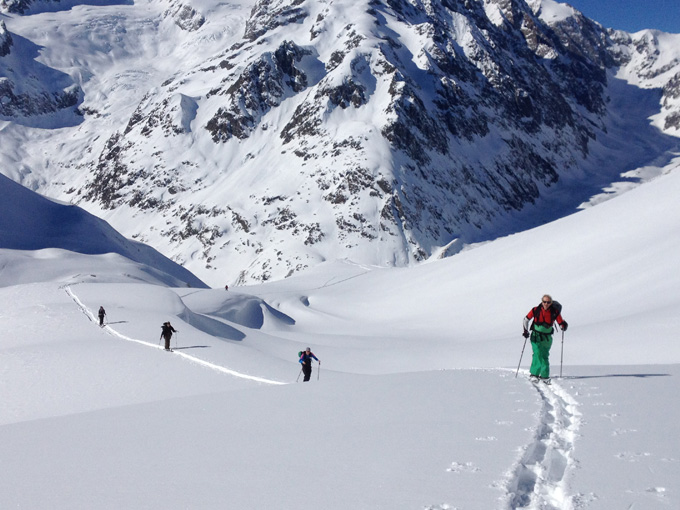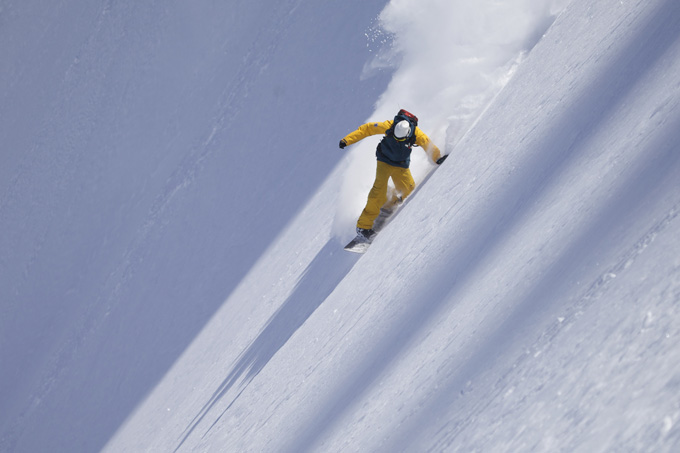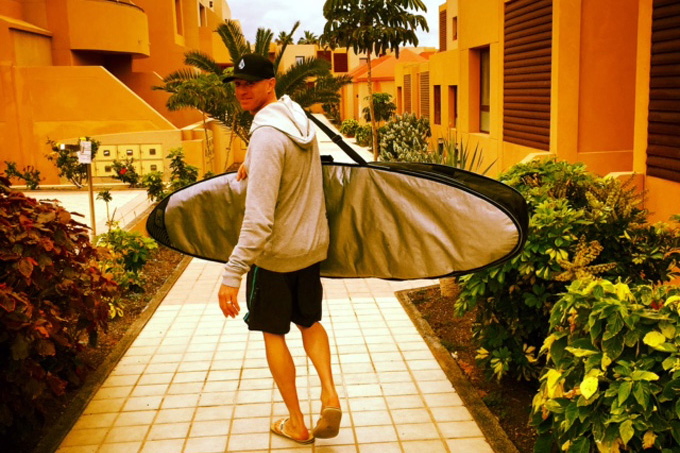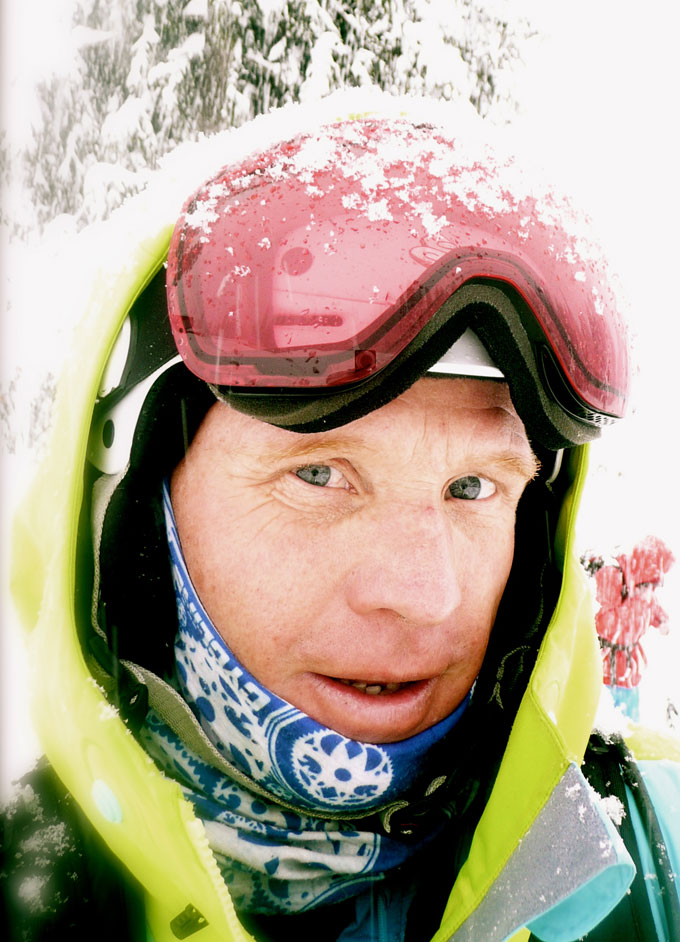
A moment in time…a day in the life of a Splitboard Guide.
The angle eases and I increase my stride, pushing each ski forwards through the deep untouched snow as I lay a track up the mountain for my clients to follow. My breathing has settled into a steady rhythm, the cold still mountain air is helping to cool me down as push on towards the top.
Soon there is no more up and I’m standing on the summit with that warm flushed feeling of tired satisfaction that only come after a prolonged steady endurance effort. I stand a moment and gaze back down the track that I have furrowed through the deep fresh snow, the group are not far behind, each one lost in their own world of effort and rhythm. My top starts to steam as the sweat evaporates in the sharp sunlight, its cold now I’ve stopped so following my own rule, I stick a layer on ‘before’ I get cold.
From here its all downhill and so we’ll relax for a moment, eat, drink and recover. We’ll change our boards from Split to Ride mode, stash out skins and stow our poles, tighten boots, swap glasses for goggles and slowly get ready for the main event.
I flick open the straps on my bindings and kick off my skis. I drop my pack and pull out a drink and a bite to eat whilst at the same time starting the transformation from uphill mode to downhill mode.
Multi tasking is key out here, this is something I’m always trying to teach my clients, stand, rest and do something, you can recover and drink, you can stand and eat, you can sit, rest, eat and start your change over all at the same time.
We’re not in rush, we have made good time on the ascent, but wasted time is wasted time and time is something we need to keep on our side. Once we’ve lost time we’re not getting it back and I always like to keep a good margin of time in hand, just to be safe.
The first of my clients arrives, he too stands steaming in the sunlight, happy to have arrived. I’m with a team of regulars and he knows the score, a brief chat and he’s already putting on his layers and making himself some space to rest and prep.
I hang my skins over my bag to dry in the sun and flip my bindings off my skis. I re set my forward lean, its one of the first things I do. I hate the sloppy feel of not enough forward lean on my board and on a splitboard I find it even more important. Once you drop in its to late to pull up and reset your spoilers, so now I make sure I do it straight away. I collapse and fold my poles, I use the z style ones that fit neatly inside my pack. It’s a pet hate of mine to have gear hanging off my pack, I like it neat, everything must fit inside. I’ve seen to many people end the day with bits of kit missing, shovel handles gone, poles missing, keep it neat, neat is good out here, neat is part of being efficient and organised, organised is good in the mountains where chaos tries to reign.

The rest of the group have arrived and are busy getting ready and eating lunch. Everyone has enjoyed the hike up from the valley, but we’re all really here for the main event and now the excitement of the descent, soon to come is starting to spread amongst us.
Now ready, I sit on my pack, enjoy the moment and finish my lunch. I am on hand if anyone needs assistance, sometimes I have to help with frozen poles, stiff bindings or un-ruley skins, but today everything seems to be in order so I relax and enjoy the view.
With everyone starting to look ready I give the 5 minute warning. Packs and Boards are checked, Goggles and gloves go on, most people are wearing helmets these days and so Goggles steaming up is less of an issue. Hiking with a helmet on is a definite ‘no go’ but a lot of Backpacks now have good helmet carrying systems and the fact that we’re not carrying our boards on our packs these days makes things a little bit easie as well.
Before the 5 minutes are up, everyone is ready with their boards on and we’re ready to head off…
The weather is perfect, the snow is cold dry crystal powder, no real change in temperature, no wind effect but I’m watching the signs. We’re riding a different aspect to the ascent, North West facing, mostly in the shade at this time of year but just picking up some weak sunlight in the afternoon, not enough to change things dramatically and I know the stability of the Snowpack underneath from watching it form through out the winter.
I’m not expecting any surprises but I’m always cautious all the same.
I move along the ridge line leaving the summit into a position from were I can see a large part of the descent and follow the fall line and signal the group to come to me.
From here, I explain the descent, where we can ride, where we can’t ride, any dangers to look out for, changes in the snowpack and snow conditions. We look at the shape of the terrain, map out safe zones, escapes, terrain traps and safe lines. I explain the line I will take and why I’ll take it. It’s a mixture of the nicest riding line, the most fun features with safe escapes should anything go amiss.
I look for surf style features mostly, banks and waves frozen into still form by the snow and wind, I love the feeling of sliding the lip, snapping cutbacks and powering deep carves. I search out drops and rollers to fly off, chutes and narrow couloirs to straight line, I like it steep, fast and flowing and I like big long pitches were I don’t have to stop, but mostly I like being safe!
The length of the pitch that we can ride depends greatly on the conditions. Today, we’ll be able to ride long pitches between stops. If it’s more technical or there are hidden factors such as the snowpack to worry about, my approach would change massively and we’d be riding short pitches one at a time.
I keep track of the changing conditions all the time. as a Guide this is a massive part of your job and dictates where and when you’ll go and why you’ll go there. I choose my routes by watching the mountains and matching the terrain that we will ride to the conditions. As such, most of the time the reason we can ride big pitches is because I’ve chosen well and I trust the conditions.
Occasionally you find yourself surrounded by factors that dictate a more cautious approach. This is especially the case if you’re riding a new line, an area that you aren’t familiar with or a tricky snowpack or one you maybe don’t know or trust.
Here you have to weigh up the pros and cons, is a safe line possible, what are the risks involved and you’re not just thinking for yourself but for all the members of the group too. I might be able to see a safe line quite easily, but now I have to make sure everyone else can see it too and more importantly, can understand where not to go and why!
Now you also have to also take into account the levels of the members of the group. Are they all capable of riding the correct line and what order do you want them to ride.
When the conditions are more difficult you rely on the knowledge that you have gained in all your years of Training, Riding and Guiding. You work with the information you get from the terrain and the mountain and you make your decisions moment by moment.
Today, I trust the conditions and I know every member of the group from the years of riding we have done together.
The descent looks amazing, an untouched canvas of sparkling white powder that flows and rolls with the steep terrain below.
One last check with the group, everyone knows the score, I’ll drop in first aiming to ride the whole pitch, if everything looks and feels right I’ll give a wave and keep going and the next can drop in as I approach the half way point and so on. Those still at the top will be on point and keep watch. I will pull up in the designated safe zone and take over the watch as they finally follow.
I check my ABS is armed and do one last check around the group.
I push my weight to my back foot and then drive forwards pushing through my front foot to drop into the fall line. I immediately feel the base of my board begin to float and become light as I sink my focus into my feet and accelerate down the slope. I make a quick deep toe side carve sinking the tail deep into the snowpack and then I release it super quick and watch for signs of release whilst at the same time maintaining sped and keeping my exit strategy ready to go.
Nothing moves, the snow feels amazing, soft deep fresh and I let my speed build before throwing another test carve to my heels.
Again all is good and release myself to the pull of gravity and begin to play.
Sometimes on a descent like this you have to really focus on the state of the snowpack as you ride. Normally, later in the season when temperature and sunlight has affected the surface tiny changes in angle and aspect, (which way the slope faces), can make enormous differences to the conditions. Even an aspect change of a few degrees can change the snow from cold powder to temperature or sun affected firm or re frozen death. The wind also changes the snowpack greatly as it carries snow around the mountain. Wind loading at the crest of the slope is obviously a major concern in terms of Avalanche danger, but also cross loading on the descent can really liven things up with some areas blown firm and others filled in. Later in the season you’ll be looking to link the cold shaded aspects with those sheltered from the wind but not loaded. Loaded snow can mean wind slab which is dangerous and also firm and not fun to ride.
After 20 plus years of this I am attuned to the changes in the snow pack and always watching and assessing things moment by moment as I ride. So many times I might ride a descent and find amazing snow top to bottom only to watch my clients mix it up on the same descent hitting sketchy firm and changeable snow. I find it frustrating sometimes and wonder why they can’t see the changes in the snows surface but they seem to enjoy it all the same. I liken it to me surfing, dropping in and getting shut down, taking the wrong wave from the wrong spot when the good guys just seem to know when and where to be and how the wave will run.
It’s definitely something that takes time but also something that we can learn and this awareness is one of the things I try to focus on with my groups. I try to get them to look at the terrain and see what has shaped and transformed it. What factors might be affecting it and what has affected it in the past. The mountains constantly give us signs and clues to follow and like me lost in the waves, it is just a matter of seeing and reading the clues, focus and practice.
To me the descent is a blank canvas on which we can create our Art. It’s my company tag line, ‘The Fine Art of Riding Mountains’ but its also something that is beautiful and flowing, something that flows with nature and with our creative expression. For me it is the chance to Surf a never ending wave with the skill and passion that I fear I’ll never achieve in the water. I’ve spent most of my life riding mountains on my Snowboard, it has become instinct, I feel everything, every movement however subtle is absorbed and controlled with out conscious thought. I push pressure, I flex the board, I drive through the edge, I sink the tail or let it slide…My feet work the board and my body follows and flows and I create my art with the mountains natural terrain.
It’s instinct, but I’m also learning and challenging it everyday. Every newdescent gives me the chance to push it a little harder, carve a little deeper and fly a little further.
Today, the conditions are near perfect. The snowpack is unchanging as we descend and the only thing we need to focus on is the creative line that we take.

I play with the banks, windlips and rollers, sliding, slashing and carving until my legs start to feel the burn and then cut out right onto a shoulder from where I have a view of both the group and the descent to come. It’s a well chosen spot, easy to get to and where we will be safe from a slide from above and from here I would also be able to see if anyone was to be carried past and pinpoint there location below. We’d also be able to follow their line without the risk of setting anything else off as we approached.
Again, the conditions are as stable as they can be and the varied angles of the terrain supports the snowpack, so the risk is minimal and as I stand an watch all I see and hear are riders cutting deep powder turns and hollering as they go.
The next section will go as the first but we’re getting lower down the mountain so we can expect the snowpack to eventually get thinner and the terrain to start to become tighter with steeper gullies and bushes.
Everything changes as you get closer to the valley. The upper mountain is always cold and so is shaped by the wind, snow and ice which makes the terrain more open and rolling, the lower mountain is shaped by warm temps, melt and rain water creating deep, steep sided gullies and waterfalls.
In the winter these gullies can become terrain traps and ice falls which can be hard to get out of or get past and the bushes can also make things tricky. Over the years these tricky exits have become known as the ‘compulsory McNab Commando finish’! The mountains aren’t always perfectly designed for us to ride…What can you do?
I keep to my ‘high ground is good ground’ mantra as things tighten up and our next stopping point will be on the high ground between two obvious gullies below giving us many different possibilities.
Again the terrain is open and we can soar, float and fly. Everything goes to plan and I pull up and as the others arrive, I start to check out the options below.
From here I can see a line on the next rise over which will give us good riding down through widely spaced bushes all the way to the tree line. It looks like it might get a bit tight through the trees but I know there is a summer path in there somewhere which is our exit, so we’re on the right track.
This next section through the bushes is great fun, the bushes shelter the snow from the wind and the sun and keep it fresh and cold, it’s fun to slalom through the branches as fast as you can looking for the gaps and jumping through the closeouts.
We regroup at the tree line and now we slow things down. The trees are thick and tight and so the snow cover is thin in places due to three shelter from above. We follow in a line as I snake my way through heading down and to right in a diagonal that should intersect with the summer path that runs from right to left.
Its actually not that far and soon we join the exit path and can ride again following it down into the valley to where the van is parked and waiting.
One by one we emerge form the woods and ride the last clearing down to the road.
Everyone looks spent but the big smiles say it all. It’s been another epic day of Splitboarding for all of us, for them, another great memory to take home and for me another successful day and another location that I now know will work for the future.
We pack up, load the van and begin the drive back to Chamonix. everyone is tired but really buzzing from the day and as they start to plan where they will meet and eat, I start to make the plans for the days to come. If this area was working then maybe I know another one that will be just as good or even better…although it might be good to go up high tomorrow, things will have settled a bit today, it stayed cold and there was no wind…
Hmm decisions, decisions…My mind is in overdrive as I start to make new plans, a plan A, a plan B and a plan C…I’ll get home and start to look at the forecasts, check wind speed, direction and the temps…I’m always thinking and always watching and always learning and tomorrow is another day.



